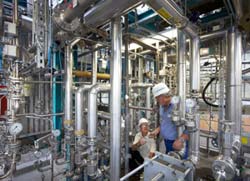Effective CO2 Capture on a Large Scale

At the Staudinger coal-fired power plant near Hanau, Germany, more than 90 percent of the carbon dioxide (CO2) in the facility’s flue gas was separated. Another result of the large-scale project, which has been running since 2009, is that the flue gas scrubbing process doesn’t reduce the plant’s efficiency to the extent that had been expected. Based on this finding, the Siemens process is also suitable for use in larger demonstration facilities.
Separation of CO2 from power plant exhaust gases is one of the ways in which plants that run on fossil fuels can help protect the climate. The CO2 is removed from the flue gas by means of Siemens’ post-combustion process. The carbon dioxide is captured with a special scrubbing agent consisting of an amino acid salt solution. These acids occur in nature and aren’t harmful to the environment. The aqueous amino acid salt solution is almost completely non-volatile, so it generates practically no solvent emissions. Unlike previous processes, the new method doesn’t require extensive cleaning of the flue gas after the carbon dioxide is captured. What’s more, the scrubbing agent removes other pollutants in the flue gas besides CO2 and can be repeatedly reused.
In addition to being very environmentally friendly, the process — which is called PostCap — is also energy efficient. Thanks to improvements to the process made by the experts at Siemens Energy, the power plant’s efficiency is only reduced by about six percentage points. That’s far less than was expected: Previous estimates had indicated a loss of about ten percentage points.
The Siemens process is suited for new power plants using fossil fuels and for retrofitting existing power stations. Siemens has a comprehensive, technologically optimized solution package for CO2 capture. This technology is part of the Siemens environmental portfolio, which generated around €28 billion in sales for the company in fiscal year 2010.
Media Contact
More Information:
http://www.siemens.com/innovationnewsAll latest news from the category: Ecology, The Environment and Conservation
This complex theme deals primarily with interactions between organisms and the environmental factors that impact them, but to a greater extent between individual inanimate environmental factors.
innovations-report offers informative reports and articles on topics such as climate protection, landscape conservation, ecological systems, wildlife and nature parks and ecosystem efficiency and balance.
Newest articles

First-ever combined heart pump and pig kidney transplant
…gives new hope to patient with terminal illness. Surgeons at NYU Langone Health performed the first-ever combined mechanical heart pump and gene-edited pig kidney transplant surgery in a 54-year-old woman…

Biophysics: Testing how well biomarkers work
LMU researchers have developed a method to determine how reliably target proteins can be labeled using super-resolution fluorescence microscopy. Modern microscopy techniques make it possible to examine the inner workings…

Making diamonds at ambient pressure
Scientists develop novel liquid metal alloy system to synthesize diamond under moderate conditions. Did you know that 99% of synthetic diamonds are currently produced using high-pressure and high-temperature (HPHT) methods?[2]…





















